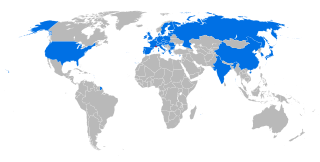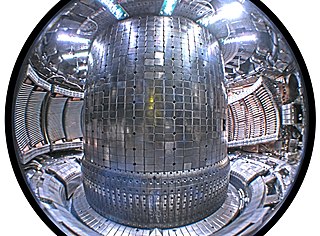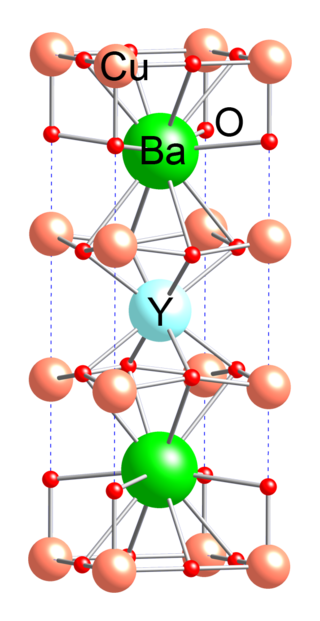Related Research Articles

A tokamak is a device which uses a powerful magnetic field generated by external magnets to confine plasma in the shape of an axially-symmetrical torus. The tokamak is one of several types of magnetic confinement devices being developed to produce controlled thermonuclear fusion power. The tokamak concept is currently one of the leading candidates for a practical fusion reactor.
Technological applications of superconductivity include:

Fusion power is a proposed form of power generation that would generate electricity by using heat from nuclear fusion reactions. In a fusion process, two lighter atomic nuclei combine to form a heavier nucleus, while releasing energy. Devices designed to harness this energy are known as fusion reactors. Research into fusion reactors began in the 1940s, but as of 2024, no device has reached net power, although net positive reactions have been achieved.
This timeline of nuclear fusion is an incomplete chronological summary of significant events in the study and use of nuclear fusion.

ITER is an international nuclear fusion research and engineering megaproject aimed at creating energy through a fusion process similar to that of the Sun. Upon completion of construction of the main reactor and first plasma, planned for late 2025, it will be the world's largest magnetic confinement plasma physics experiment and the largest experimental tokamak nuclear fusion reactor. It is being built next to the Cadarache facility in southern France. ITER will be the largest of more than 100 fusion reactors built since the 1950s, with ten times the plasma volume of any other tokamak operating today.

The T-15 is a Russian nuclear fusion research reactor located at the Kurchatov Institute, which is based on the (Soviet-invented) tokamak design. It was the first industrial prototype fusion reactor to use superconducting magnets to control the plasma. These enormous superconducting magnets confined the plasma the reactor produced, but failed to sustain it for more than just a few seconds. Despite not being immediately applicable, this new technological advancement proved to the USSR that they were on the right path. In the original shape, a toroidal chamber design, it had a major radius of 2.43 m and minor radius 0.7 m.

Magnetic confinement fusion (MCF) is an approach to generate thermonuclear fusion power that uses magnetic fields to confine fusion fuel in the form of a plasma. Magnetic confinement is one of two major branches of controlled fusion research, along with inertial confinement fusion.

DEMO, or a demonstration power plant, refers to a proposed class of nuclear fusion experimental reactors that are intended to demonstrate the net production of electric power from nuclear fusion. Most of the ITER partners have plans for their own DEMO-class reactors. With the possible exception of the EU and Japan, there are no plans for international collaboration as there was with ITER.

The Plasma Science and Fusion Center (PSFC) at the Massachusetts Institute of Technology (MIT) is a university research center for the study of plasmas, fusion science and technology.

The KSTAR is a magnetic fusion device at the Korea Institute of Fusion Energy in Daejeon, South Korea. It is intended to study aspects of magnetic fusion energy that will be pertinent to the ITER fusion project as part of that country's contribution to the ITER effort. The project was approved in 1995, but construction was delayed by the East Asian financial crisis, which weakened the South Korean economy considerably; however, the project's construction phase was completed on September 14, 2007. The first plasma was achieved in June 2008.
Ignitor is the Italian name for a planned tokamak device, developed by ENEA. As of 2022, the device has not been constructed.
SST-1 is a plasma confinement experimental device in the Institute for Plasma Research (IPR), an autonomous research institute under Department of Atomic Energy, India. It belongs to a new generation of tokamaks with the major objective being steady state operation of an advanced configuration plasma. It has been designed as a medium-sized tokamak with superconducting magnets.

A spherical tokamak is a type of fusion power device based on the tokamak principle. It is notable for its very narrow profile, or aspect ratio. A traditional tokamak has a toroidal confinement area that gives it an overall shape similar to a donut, complete with a large hole in the middle. The spherical tokamak reduces the size of the hole as much as possible, resulting in a plasma shape that is almost spherical, often compared to a cored apple. The spherical tokamak is sometimes referred to as a spherical torus and often shortened to ST.

In nuclear fusion power research, the plasma-facing material (PFM) is any material used to construct the plasma-facing components (PFC), those components exposed to the plasma within which nuclear fusion occurs, and particularly the material used for the lining the first wall or divertor region of the reactor vessel.
The Lockheed Martin Compact Fusion Reactor (CFR) was a fusion power project at Lockheed Martin’s Skunk Works. Its high-beta configuration, which implies that the ratio of plasma pressure to magnetic pressure is greater than or equal to 1, allows a compact design and expedited development. The project was active between 2010 and 2019, after that date there have been no updates and it appears the division has shut down.
Commonwealth Fusion Systems (CFS) is an American fusion power company founded in 2018 in Cambridge, Massachusetts after a spin-out from the Massachusetts Institute of Technology (MIT). Its stated goal is to build a small fusion power plant based on the ARC tokamak design. It has participated in the United States Department of Energy’s INFUSE public-private knowledge innovation scheme, with several national labs and universities.

Rare-earth barium copper oxide (ReBCO) is a family of chemical compounds known for exhibiting high-temperature superconductivity (HTS). ReBCO superconductors have the potential to sustain stronger magnetic fields than other superconductor materials. Due to their high critical temperature and critical magnetic field, this class of materials are proposed for use in technical applications where conventional low-temperature superconductors do not suffice. This includes magnetic confinement fusion reactors such as the ARC reactor, allowing a more compact and potentially more economical construction, and superconducting magnets to use in future particle accelerators to come after the Large Hadron Collider, which utilizes low-temperature superconductors.

SPARC is a tokamak under development by Commonwealth Fusion Systems (CFS) in collaboration with the Massachusetts Institute of Technology (MIT) Plasma Science and Fusion Center (PSFC). Funding has come from Eni, Breakthrough Energy Ventures, Khosla Ventures, Temasek, Equinor, Devonshire Investors, and others.
The history of nuclear fusion began early in the 20th century as an inquiry into how stars powered themselves and expanded to incorporate a broad inquiry into the nature of matter and energy, as potential applications expanded to include warfare, energy production and rocket propulsion.
The Compact Ignition Tokamak (CIT) was a plasma physics experiment that was designed but not built. It was designed by an inter-organizational team in the US led by Princeton Plasma Physics Laboratory. The experiment was designed to achieve a self-sustaining Thermonuclear fusion reaction (ignition) in a Tokamak with the minimum possible budget.
References
- 1 2 3 4 "Advances in magnet technology could bring cheaper, modular fusion reactors from sci-fi to sci-reality in less than a decade". 11 August 2015. Retrieved 2015-08-12.
- 1 2 3 4 5 6 7 8 Sorbom, B. N.; Ball, J.; Palmer, T. R.; Mangiarotti, F. J.; Sierchio, J. M.; Bonoli, P.; Kasten, C.; Sutherland, D. A.; Barnard, H. S. (2014-09-10). "ARC: A compact, high-field, fusion nuclear science facility and demonstration power plant with demountable magnets". Fusion Engineering and Design. 100: 378–405. arXiv: 1409.3540 . Bibcode:2015FusED.100..378S. doi:10.1016/j.fusengdes.2015.07.008. S2CID 1258716.
- ↑ Devlin, Hannah (9 March 2018). "Nuclear fusion on brink of being realised, say MIT scientists". the Guardian. Retrieved 16 April 2018.
- ↑ Rathi, Akshat (26 September 2018). "In search of clean energy, investments in nuclear-fusion startups are heating up". Quartz. Retrieved 2020-09-08.
- ↑ Systems, Commonwealth Fusion. "Commonwealth Fusion Systems Raises $115 Million and Closes Series A Round to Commercialize Fusion Energy". www.prnewswire.com (Press release). Retrieved 2020-09-08.
- ↑ Systems, Commonwealth Fusion. "Commonwealth Fusion Systems Raises $84 Million in A2 Round". www.prnewswire.com (Press release). Retrieved 2020-09-08.
- ↑ Sorbom, B. N.; Ball, J.; Palmer, T. R.; Mangiarotti, F. J.; Sierchio, J. M.; Bonoli, P.; Kasten, C.; Sutherland, D. A.; Barnard, H.S.; Haakonsen, C. B.; Goh, J.; Sung, C.; Whyte, D. G. (2015). "ARC: A compact, high-field, fusion nuclear science facility and demonstration power plant with demountable magnets". Fusion Engineering and Design. 100: 378–405. arXiv: 1409.3540 . Bibcode:2015FusED.100..378S. doi:10.1016/j.fusengdes.2015.07.008. S2CID 1258716.
- ↑ SPARC project official brochure Archived 2019-06-20 at the Wayback Machine , p. 19
- ↑ SPARC project official brochure Archived 2019-06-20 at the Wayback Machine , p. 25